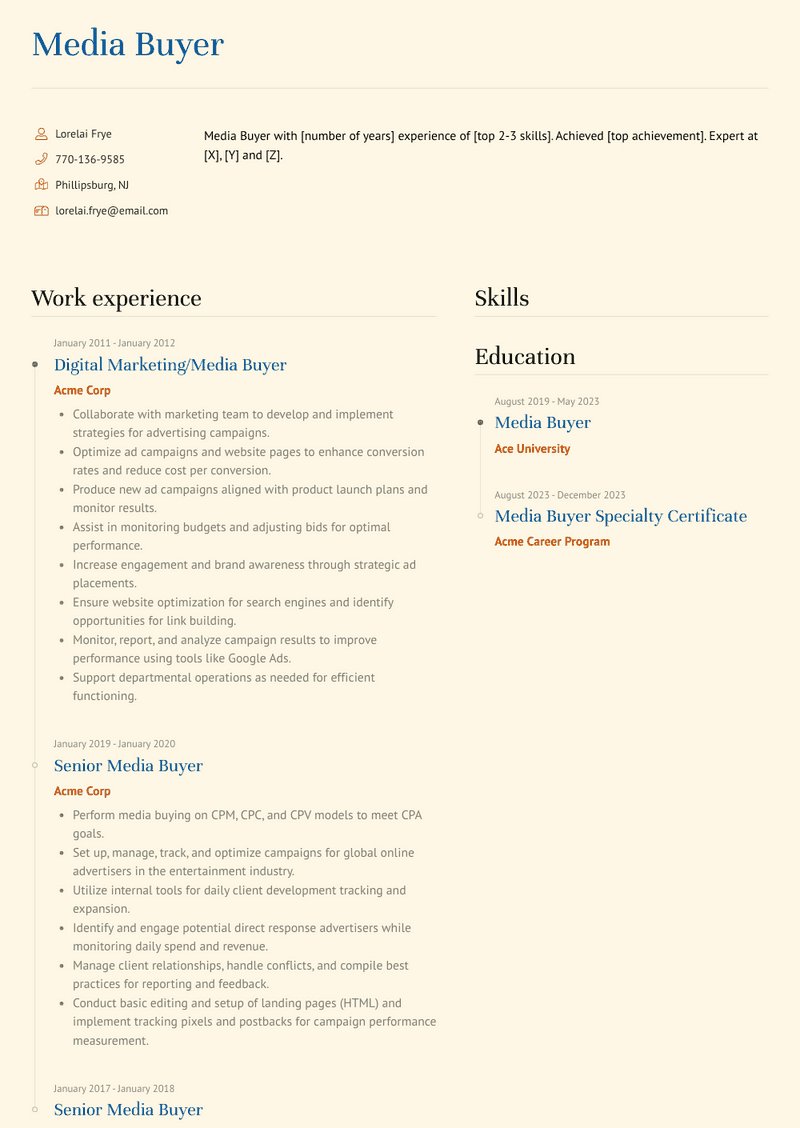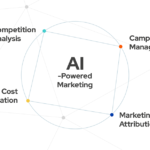Best media buying strategies for 2024 include leveraging data-driven insights and embracing programmatic advertising. Prioritizing audience segmentation and optimizing cross-channel campaigns are also crucial.
In 2024, the media buying landscape will continue to evolve with advancements in technology and data analytics. Marketers must harness data-driven insights to make informed decisions, ensuring their campaigns resonate with target audiences. Programmatic advertising will play a significant role, allowing for more precise targeting and real-time optimization.
Audience segmentation remains essential, enabling brands to tailor their messages for different consumer groups effectively. Cross-channel optimization ensures that campaigns reach potential customers through multiple touchpoints, maximizing engagement and conversions. By adopting these strategies, businesses can stay competitive and achieve better ROI in their media buying efforts.
Introduction To Media Buying
Media buying is crucial for digital marketing success. It involves purchasing ad space to reach the target audience. This guide will help you understand its importance and best strategies for 2024.
What Is Media Buying?
Media buying is the process of purchasing ad placements. These ads can appear on various platforms like websites, TV, radio, and social media. The goal is to reach the right audience at the right time.
Media buyers work with advertisers to choose the best platforms. They negotiate the cost and schedule for ad placements. They also monitor the performance of the ads.
Effective media buying requires research and strategy. It ensures ads reach the target audience efficiently. This process helps maximize the return on investment (ROI).
Importance In Digital Marketing
Media buying plays a vital role in digital marketing. It helps businesses reach potential customers. With the right strategy, ads can appear on platforms where the audience spends time.
Here are some key benefits of media buying in digital marketing:
- Increased Brand Awareness: Ads on popular platforms increase visibility.
- Targeted Advertising: Reach specific demographics based on interests and behavior.
- Cost Efficiency: Optimize ad spend by choosing the most effective platforms.
- Data-Driven Decisions: Use analytics to track performance and refine strategies.
By leveraging media buying, businesses can achieve their marketing goals. It ensures ads are seen by the right people at the right time, leading to higher engagement and conversions.
Setting Clear Objectives
Setting clear objectives is crucial for successful media buying in 2024. Without clear goals, your media buying efforts might miss the mark. Effective planning can ensure your media campaigns meet your business needs.
Defining Goals
Defining specific goals helps guide your media buying strategy. Clear goals provide a roadmap for your team. Here are some steps to define your goals:
- Identify your target audience: Know who you want to reach.
- Set measurable objectives: Use numbers to define success.
- Determine your budget: Allocate funds wisely.
For example, if your goal is to increase brand awareness, you might set a target of reaching 1 million impressions within six months.
Aligning With Business Strategy
Your media buying objectives should align with your overall business strategy. This alignment ensures consistency across all marketing efforts. Here are some ways to align your objectives:
- Understand your business goals: Know your company’s priorities.
- Integrate marketing and sales: Ensure both teams work together.
- Monitor performance: Regularly review your campaign’s success.
For instance, if your business goal is to boost sales, your media buying strategy should focus on channels that drive conversions.
Below is a table illustrating how to align media buying objectives with business goals:
| Business Goal | Media Buying Objective | Key Performance Indicator |
|---|---|---|
| Increase Brand Awareness | Reach 1 million impressions | Impressions Count |
| Boost Sales | Increase conversion rate by 10% | Conversion Rate |
| Engage Audience | Achieve 5,000 social media shares | Social Media Shares |
Setting clear objectives is essential for optimizing your media buying strategy. By defining goals and aligning them with your business strategy, you can achieve significant results in 2024.
Target Audience Analysis
Understanding your target audience is crucial for effective media buying. It helps in creating personalized and impactful campaigns. This section will delve into the best practices for target audience analysis in 2024.
Understanding Your Audience
Knowing your audience is the first step in media buying. You need to identify who they are, their needs, and preferences. This information guides your media buying strategy.
Start with demographic details like age, gender, and location. Add psychographic data such as interests, values, and lifestyle. Use this data to create a detailed audience profile.
Use tools like Google Analytics and social media insights. These tools provide valuable data about your audience’s behavior.
Create surveys and feedback forms. This helps gather direct input from your audience. Use this feedback to refine your understanding.
Segmenting For Precision
Segmenting your audience allows for more targeted campaigns. It ensures your message reaches the right people. Break down your audience into smaller groups based on specific criteria.
- Demographic Segmentation: Age, gender, income, education
- Geographic Segmentation: Location, climate, urban/rural
- Psychographic Segmentation: Lifestyle, values, interests
- Behavioral Segmentation: Purchase behavior, brand loyalty, usage rate
Use CRM systems and customer data platforms for effective segmentation. These tools help in organizing and analyzing customer data.
Here’s a simple table for quick reference:
| Segmentation Type | Criteria | Examples |
|---|---|---|
| Demographic | Age, Gender, Income | 18-24, Male, High income |
| Geographic | Location, Climate | Urban, Tropical |
| Psychographic | Lifestyle, Values | Health-conscious, Eco-friendly |
| Behavioral | Purchase behavior, Usage rate | Frequent buyer, Heavy user |
Applying these strategies ensures more precise and effective media buying. Target audience analysis is key to success in 2024.

Credit: www.visualcv.com
Choosing The Right Channels
Choosing the right channels for media buying is crucial. It ensures your ads reach the target audience effectively. In 2024, media options are vast. Your strategy must be smart and adaptive. Let’s dive into the best media buying strategies for 2024.
Digital Vs. Traditional Media
Digital media includes social media, websites, and online ads. It’s fast and can target specific audiences. You can adjust your campaigns quickly. Traditional media includes TV, radio, and print ads. It reaches a broad audience and is trusted by many people.
Which one is better? It depends on your goals. Digital media is great for quick results and targeted ads. Traditional media is best for brand awareness and reaching older audiences.
| Digital Media | Traditional Media |
|---|---|
| Targeted ads | Broad reach |
| Quick adjustments | Trusted sources |
| Lower costs | Higher costs |
Evaluating Channel Performance
Evaluating channel performance helps you understand what’s working. Use metrics and data to measure success. Key metrics include:
- Click-through rate (CTR): How many people click your ad.
- Conversion rate: How many people take action.
- Return on ad spend (ROAS): Profit from your ad spend.
Use tools like Google Analytics for digital media. For traditional media, use surveys and sales data. Always compare performance against your goals.
Budget Allocation
Effective budget allocation is crucial for successful media buying in 2024. Smart allocation ensures resources are used wisely. This leads to better returns on investment. Let’s dive into the best strategies for setting and optimizing your media budget.
Setting A Budget
Setting a budget is the first step in media buying. Start by defining your marketing goals. Identify your target audience and their preferences. This helps in allocating funds to the right channels.
Analyze past campaign performances. Use data to predict future trends. Allocate funds based on these insights.
Consider using a budget calculator. This tool helps in distributing your funds effectively. It ensures you cover all essential areas without overspending.
| Channel | Percentage of Budget |
|---|---|
| Social Media | 40% |
| Search Engines | 30% |
| Email Marketing | 20% |
| Content Marketing | 10% |
Optimizing Spend
Optimizing spend ensures your budget is used wisely. Regularly review your campaign performance. Adjust your spending based on the results.
Use A/B testing to determine the best-performing ads. Allocate more funds to high-performing campaigns. This approach maximizes your returns.
Leverage data analytics tools. These tools provide insights into audience behavior. Use this data to refine your strategies.
- Track key metrics regularly.
- Identify underperforming channels.
- Reallocate funds to high-performing channels.
- Continuously test and optimize your ads.
Consider using programmatic advertising. It automates the ad-buying process. This ensures your ads reach the right audience at the right time.

Credit: twitter.com
Negotiating With Vendors
Negotiating with vendors is an essential skill for media buying in 2024. It ensures you get the best value for your budget. Effective negotiation can lead to better ad placements and improved ROI.
Building Relationships
Building strong relationships with vendors is crucial. Trust and mutual respect lead to better deals. Start by understanding the vendor’s needs and goals. Show genuine interest in their success.
- Communicate regularly
- Attend industry events
- Offer feedback
Regular communication helps in maintaining a healthy relationship. Attend industry events to meet vendors in person. Offering feedback shows you value their service.
Securing The Best Rates
Securing the best rates requires a strategic approach. Conduct thorough research before negotiations. Know the market rates and the vendor’s pricing structure.
| Strategy | Benefit |
|---|---|
| Volume Discounts | Lower cost per unit |
| Long-term Contracts | More favorable terms |
| Bundling Services | Cost savings |
Consider volume discounts for large purchases. Long-term contracts can provide more favorable terms. Bundling services can lead to significant cost savings.
Be prepared to negotiate assertively but fairly. Know your budget limits and stick to them. Always aim for a win-win outcome.
Utilizing Data And Analytics
Media buying has evolved with the rise of data and analytics. Advertisers now rely on data for smarter decisions. In 2024, utilizing data and analytics will be key. This approach helps in maximizing ROI and ensuring targeted advertising. Let’s dive into how you can track performance and adjust strategies effectively.
Tracking Performance
Tracking performance is essential in media buying. Use tools like Google Analytics and Facebook Insights. These tools provide valuable data on ad performance. Key metrics to track include:
- Click-Through Rate (CTR)
- Conversion Rate
- Cost Per Click (CPC)
- Return on Ad Spend (ROAS)
Setting up tracking pixels on your website is crucial. Pixels help in gathering detailed user behavior data. This data can be used to refine targeting and improve ad performance.
Adjusting Strategies
Adjusting strategies based on data insights is vital. Regularly analyze your campaign data. Identify what’s working and what’s not. Here are steps to adjust your strategies:
- Review Key Metrics: Focus on CTR, CPC, and conversions.
- Identify Trends: Look for patterns in the data.
- Test Variations: A/B test different ad creatives and messages.
- Optimize Budget: Allocate more budget to high-performing ads.
- Refine Targeting: Adjust audience targeting based on insights.
Using data to adjust strategies ensures you stay ahead. This method helps in achieving better results in 2024.
Leveraging Technology
In 2024, media buying strategies will lean heavily on technology. Leveraging advanced tools can boost efficiency and accuracy. Companies now use tech to target the right audience.
Programmatic Buying
Programmatic buying is automating the purchase of digital ad space. This process uses software to buy ads in real-time. It eliminates the need for manual orders and negotiations.
There are many benefits to programmatic buying:
- Increased efficiency
- Precise targeting
- Real-time data analysis
Real-time bidding (RTB) is a key aspect of programmatic buying. It allows advertisers to bid on ad space in milliseconds. This ensures ads reach the right audience at the best time.
Ai And Machine Learning
AI and Machine Learning are game-changers in media buying. These technologies can predict trends and optimize ad placements.
With AI, advertisers can:
- Analyze large datasets quickly
- Identify target demographics
- Improve ad performance
Machine learning algorithms learn from data. They improve over time, making ad targeting more accurate. This leads to higher ROI and better use of ad budgets.
| Technology | Benefits |
|---|---|
| Programmatic Buying | Efficiency, Precision, Real-time Analysis |
| AI and Machine Learning | Trend Prediction, Data Analysis, Improved ROI |
Incorporating these technologies in media buying strategies is crucial for 2024. It ensures ads are efficient and effective.
Case Studies And Success Stories
Understanding the best media buying strategies for 2024 involves examining real-life case studies. Success stories from leading brands provide valuable insights. These examples highlight effective techniques and innovative approaches. Let’s dive into some standout cases.
Brands That Nailed It
Several brands achieved remarkable success with their media buying strategies. Here are some noteworthy examples:
| Brand | Strategy | Results |
|---|---|---|
| Brand A | Programmatic Advertising | Increased ROI by 45% |
| Brand B | Social Media Campaigns | Boosted engagement by 60% |
| Brand C | Influencer Partnerships | Grew follower base by 30% |
Lessons Learned
These success stories reveal important lessons:
- Data-Driven Decisions: Using data improves targeting and ROI.
- Creative Content: Engaging content captures audience attention.
- Multi-Channel Approach: Leveraging multiple channels maximizes reach.
- Continuous Optimization: Regularly tweaking strategies enhances performance.
Implementing these lessons can transform your media buying strategy. Stay ahead with these proven approaches.
Future Trends In Media Buying
The future of media buying is evolving rapidly. In 2024, new trends will shape the industry. Staying ahead requires understanding these trends. Let’s explore the future of media buying.
Emerging Technologies
Emerging technologies will redefine media buying. These innovations promise greater efficiency and accuracy.
- Artificial Intelligence (AI) – AI will automate ad placements. It will optimize targeting and bidding.
- Programmatic Advertising – Programmatic ads will become more advanced. They will offer real-time bidding and data-driven decisions.
- Blockchain Technology – Blockchain ensures transparency. It will prevent ad fraud and enhance trust.
- 5G Technology – 5G will revolutionize media consumption. Faster speeds will enable richer ad content.
Predictions For 2024
Experts predict several key trends for 2024. These trends will shape media buying strategies.
- Increased Personalization – Ads will become more personalized. AI will analyze user behavior and preferences.
- Omnichannel Marketing – Integrating multiple channels will be crucial. Consistent messaging across platforms will enhance user experience.
- Voice Search Optimization – Voice search will grow. Optimizing ads for voice search will become essential.
- Interactive Ad Formats – Interactive ads will engage users better. Formats like AR and VR will gain popularity.
- Data Privacy Regulations – Stricter regulations will impact targeting. Compliance will be a top priority.
Understanding these trends is vital. Adapting to them will ensure success in media buying.

Credit: sproutsocial.com
Frequently Asked Questions
What Is The Future Of Media Buying?
The future of media buying focuses on automation, data-driven strategies, and personalized content. AI and machine learning optimize ad placements.
What Are Media Buying Strategies?
Media buying strategies involve selecting the best platforms, negotiating ad placements, targeting the right audience, and optimizing budgets for maximum ROI.
How To Master Media Buying?
Master media buying by understanding your audience, setting clear goals, researching platforms, optimizing campaigns, and analyzing performance.
What Is A Media Buying Platform?
A media buying platform automates the purchase of digital ad space. It streamlines ad placement, targeting, and performance tracking.
Conclusion
Mastering media buying strategies in 2024 can boost your campaign success. Focus on data-driven decisions and audience targeting. Continuously adapt to industry trends for optimal results. Implement these tactics to maximize ROI and stay ahead of competitors. Your media buying efforts will yield greater returns with these proven strategies.




